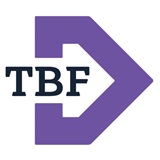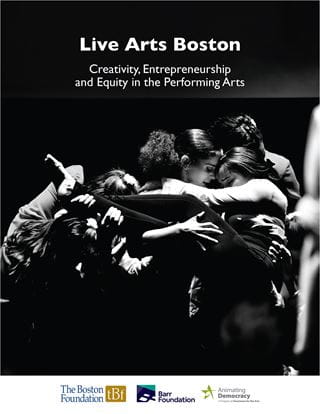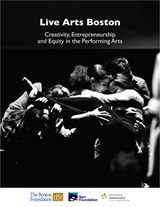Live Arts Boston has brought so much vitality to the independent arts scene in Boston that it’s hard to remember that it was launched as a three-year pilot program in 2017. Since then, Live Arts Boston (LAB) has funded 240 performing artists, small arts groups and arts promotion organizations to give 1,100 performances and infused $2.3 million into the local arts economy—where, notably, grant money was heavily used by grantee artists to pay other artists and arts technicians. More than 70 percent of the funded projects were led by people of color.
These and many more juicy facts and trends were shared at a recent forum and discussion with the release of an
assessment report on learnings from the pilot stage of the program. The Boston Foundation
President and CEO Paul Grogan and Interim Director of Arts & Culture Eva Rosenberg opened the program, contextualizing how LAB continues the Foundation’s tradition of arts sector support with a new emphasis on equity, entrepreneurship and trust. Then, researchers Barbara Schaffer Bacon and Pam Korza, Co-Directors of
Animating Democracy, shared their report. The findings came from stats from artists’ grant applications and grantee reports, as well as surveys and interviews with grantees, applicants and LAB staff. The number-one recommendation to come from their analysis was to continue the program as a core part of the
Boston Foundation’s Arts & Culture strategy. Other recommendations included strengthening the networks connecting artists, illuminatating and acting on conditions facing artists in Boston, and cultivating philanthropic investment in the performing arts.
In its pilot phase, LAB supported some 60 performing arts projects a year, but didn’t just grant the money and run. By placing very few restrictions on the funds (mainly, give a performance of a finished or in-progress work), the program trusted artists to know what they needed, but also helped them pursue it. With a mentor-matching element and numerous gatherings and workshops on the business side of the performing arts, LAB helped artists connect to creative and business partners alike. Because small and less “mainstream” performances can face hurdles when booking established performance venues, an amazing array of new performance spaces was explored, from studios to shelters andcolleges to cemeteries. Collaborations abounded and 42 percent of the performances in the pilot period were multidisciplinary. See the report’s web summary or read the whole report for further details.
The discussion following the data presentation did what Live Arts Boston does best—put artists in the driver’s seat. Three LAB grantees—Afro-Latin dance specialist and company leader Ana Masacote, hip hop recording artist and composer Billy Dean Thomas, and taiko drummer, cultural organizer and educator Karen Young—joined Rosenberg in conversation about the Boston arts scene and the impact of LAB.
“Boston has a reputation of being unfriendly to artists of color,” Masacote observed, “and we are in fact being gentrified out. Besides funding, what if venues could give space and help to get press and promotion through their networks? That could change the trajectory of how the arts are seen here.” All three agreed that a little more of this has been happening through their LAB connections. Young said, “I’m finding myself more often in spaces with folks from established institutions to talk about these things than in the past. And yet, it’s such a system, just filling out forms can be challenging”—a lot of creatives don’t fit the mold the forms are expecting, which throws up barriers to getting their work seen. Thomas agreed that LAB has opened more doors, largely due to “the building of networks among artists, who are often in silos, as well as with institutions,” also noting that the financial impact on the artistic ecosystem has been huge.
Meanwhile, as Masacote pointed out, the pandemic highlighted inequity in the arts as much as in other spheres. Young conveyed the distress of many, saying, “It’s very difficult to have gone suddenly from live performances (in my case for decades), to interacting only with my laptop. If your practice is built on physicality and interaction, it has been traumatizing.” Rosenberg reiterated a theme in the conversation--that artists aren’t just flaky creative people, but also entrepreneurs and small business folk)—pointing out that they are “creative workers who have to be part of any planned recovery.” The pandemic has been especially rough on the performing arts, it’s true, but Thomas has noted a change in some organizations’ willingness to try something different, saying, “LAB has been a wonderful channel that connects practitioners and media and institutions… And given that they can’t do the usual, they’re more open to doing something not done before. I’d love to see more of that daring continue—we have to do it at this point—to try some new things.”
Before the event concluded with a cello performance by LAB grantee Naseem Allatrash, Thomas injected another note of hope about the role of artists. “Trust is going to be a big word for our recovery. Like LAB’s implicit trust in artists to know what they need. [We’ll need trust] to let artists reshape and twist things. That’s what we do.”



